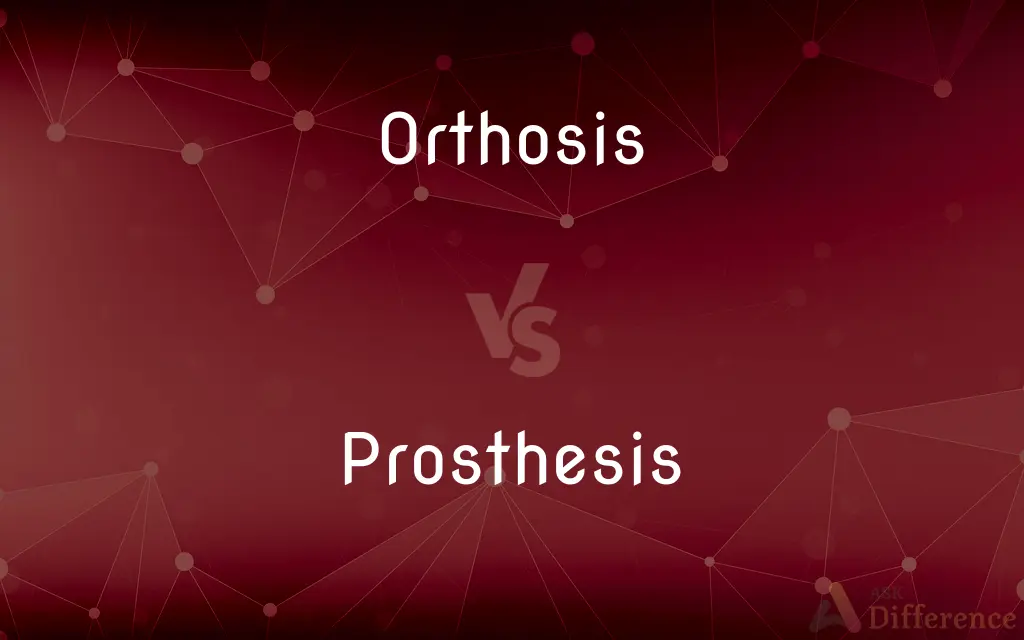Orthosis vs. Prosthesis — What's the Difference?
By Urooj Arif & Fiza Rafique — Updated on May 2, 2024
Orthosis refers to a device designed to support, align, or correct deformities or to improve the function of movable body parts, while a prosthesis is an artificial device that replaces a missing body part.

Difference Between Orthosis and Prosthesis
Table of Contents
ADVERTISEMENT
Key Differences
An orthosis is a device used to support or correct the function of a limb or the torso. It is typically used by individuals who have a weakness or deformity that impairs their physical function. Prosthesis, on the other hand, refers to an artificial replacement for a missing part of the body, commonly used by amputees or those born without a limb.
Orthoses are designed to enhance the functionality of a body part without replacing it. They can help stabilize joints, reduce pain, and prevent further disabilities. Whereas prostheses are designed to substitute for the missing limb or body part, enabling the wearer to perform activities that would be difficult or impossible otherwise.
The use of an orthosis generally assists in mobility or alleviation of discomfort but does not replace a body part. On the other hand, a prosthesis is integral in replacing the function and, to some extent, the appearance of a missing limb or organ, such as an arm, leg, or even breast.
While orthoses can be temporary, used during the period of recovery from an injury, prostheses are usually a permanent solution aimed at enhancing life quality for those missing a part of their body. This highlights a fundamental difference in duration and intent of use between the two devices.
Orthotic devices are often part of a therapeutic process and may be adjusted or discarded as a patient’s condition improves or changes. Conversely, prosthetic devices may require adjustments due to changes in the wearer’s body size or shape but are generally intended to be a long-term or lifelong solution.
ADVERTISEMENT
Comparison Chart
Purpose
Support and enhance existing body parts
Replace missing body parts
Use Case
Correct deformities, improve function
Enable functionality of absent body parts
Duration of Use
Often temporary or adjustable
Typically permanent
Contribution to Mobility
Enhances or supports movement
Replaces essential functions
Customization
Custom fitted for support
Custom made to replace and fit body contours
Compare with Definitions
Orthosis
A tool used in the treatment and rehabilitation of physical disorders.
The child used an orthosis to correct the position of his feet while walking.
Prosthesis
An artificial device to replace a missing part of the body.
The soldier was fitted with a prosthesis after losing his leg in the war.
Orthosis
An externally applied device used to modify the structural characteristics of the neuromuscular and skeletal systems.
An ankle-foot orthosis helped her walk after the stroke.
Prosthesis
A device designed to improve the function of a missing body part.
His hand prosthesis allowed him to grasp and hold objects.
Orthosis
A device designed to support or correct the musculoskeletal system.
She wore an orthosis to correct her spinal curvature.
Prosthesis
An artificial replacement that restores normal function or appearance.
After her mastectomy, she chose a breast prosthesis.
Orthosis
A brace or other artificial support used to correct alignment or improve function.
After the knee injury, he used an orthosis to stabilize the joint.
Prosthesis
A permanent fixture to aid those missing a limb.
He adjusted quickly to his new prosthesis, which allowed him greater mobility.
Orthosis
A corrective or supportive device worn on the body.
His orthosis relieves pain by redistributing pressure away from the damaged area.
Prosthesis
A manufactured substitute for a missing limb or part of a limb.
She learned to walk again using her new leg prosthesis.
Orthosis
(medicine) A type of brace which either prevents or assists movement of a limb or the spine.
Prosthesis
In medicine, a prosthesis (plural: prostheses; from Ancient Greek prosthesis, "addition, application, attachment") or prosthetic implant is an artificial device that replaces a missing body part, which may be lost through trauma, disease, or a condition present at birth (congenital disorder). Prostheses are intended to restore the normal functions of the missing body part.
Prosthesis
An artificial device used to replace a missing body part, such as a limb, tooth, eye, or heart valve.
Prosthesis
Replacement of a missing body part with such a device.
Prosthesis
(Linguistics) Prothesis.
Prosthesis
(medicine) An artificial replacement for a body part, either internal or external.
Prosthesis
Prothesis.
Prosthesis
The addition to the human body of some artificial part, to replace one that is wanting, as a log or an eye; - called also prothesis.
Prosthesis
The prefixing of one or more letters to the beginning of a word, as in beloved.
Prosthesis
Corrective consisting of a replacement for a part of the body
Common Curiosities
Is a prosthesis considered a medical device?
Yes, a prosthesis is a medical device that replaces a missing body part and is typically custom-made for the individual.
What is a prosthesis?
A prosthesis is an artificial replacement for a missing part of the body, designed to restore functionality or aesthetics.
Who might need an orthosis?
Individuals with musculoskeletal weaknesses, deformities, or injuries might require an orthosis to improve function or alleviate pain.
Can children use orthoses?
Yes, children often use orthoses to correct growth abnormalities or support weak limbs.
Can orthosis help in rehabilitation?
Yes, orthoses are commonly used in rehabilitation to support weak or injured body parts and aid recovery.
What are the types of prostheses?
There are many types, including limb prostheses (like arms and legs), cranial/facial prostheses, and internal prostheses like heart valves.
Are orthoses comfortable to wear?
Comfort depends on proper fit and design; professional fitting and periodic adjustments are essential for comfort.
How long does an orthosis last?
The lifespan of an orthosis varies based on the material, usage, and whether the wearer's condition changes.
What is the adjustment period for a new prosthesis?
The adjustment period can vary, often taking several weeks to months as the user learns to use and accommodate the new prosthesis effectively.
What is an orthosis?
An orthosis is a supportive device used to correct or support bodily functions and structures.
What materials are used in orthoses?
Orthoses can be made from various materials, including metal, plastic, and composite materials, depending on the required support and flexibility.
Can anyone use a prosthesis?
Most people can use a prosthesis, but success highly depends on personal health, the area of amputation, and individual adaptation.
How is a prosthesis fitted?
A prosthesis is custom-fitted by a prosthetist to ensure it meets the specific needs and dimensions of the user's body.
What factors influence the choice between an orthosis and a prosthesis?
Factors include the nature of the physical condition (missing limb vs. support for existing limb), goals of treatment, and overall health status.
How does a prosthesis improve quality of life?
A prosthesis can significantly enhance the quality of life by enabling mobility, independence, and the ability to perform daily activities.
Share Your Discovery

Previous Comparison
Silky vs. Smooth
Next Comparison
Onset vs. OutsetAuthor Spotlight
Written by
Urooj ArifUrooj is a skilled content writer at Ask Difference, known for her exceptional ability to simplify complex topics into engaging and informative content. With a passion for research and a flair for clear, concise writing, she consistently delivers articles that resonate with our diverse audience.
Co-written by
Fiza RafiqueFiza Rafique is a skilled content writer at AskDifference.com, where she meticulously refines and enhances written pieces. Drawing from her vast editorial expertise, Fiza ensures clarity, accuracy, and precision in every article. Passionate about language, she continually seeks to elevate the quality of content for readers worldwide.













































